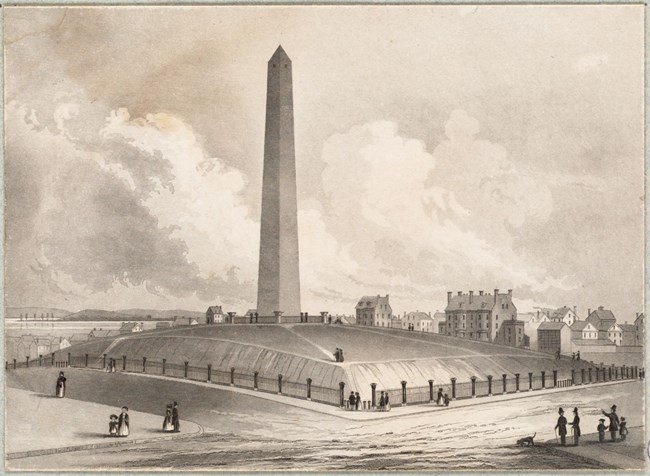Last updated: January 6, 2025
Article
Restoring Bunker Hill's Fence

Student Conservation Association photo, A. Lueth
The Student Conservation Association Massachusetts Historic Preservation Corp (SCA HPC) has been restoring the wrought iron fence around the Bunker Hill Monument, applying a new coat of paint to bring it back to its original quality. The project began in 2023, with each subsequent year’s crew repainting one of the four sides of the fence. As of 2024, two sides have been painted, and the project is slated to be completed by 2026.
Site History

Boston Public Library
The Monument sits on Breed's Hill, the site of the Battle of Bunker Hill, one of the earliest battles of the Revolutionary War. Constructed from 1825 to 1842, the Bunker Hill Monument commemorates the soldiers who fought in the battle.[1] The park's iron fence was originally installed in 1843, followed by a new iron fence in 1870, the one that still stands today.[2]
Learn more about the Bunker Hill Monument and the efforts to preserve the Monument over the years.
Project Overview
Left image
One of the bottom portions of the fence BEFORE painting was completed.
Credit: Student Conservation Association photo, A. Lueth
Right image
One of the bottom portions of the fence AFTER painting was completed
Credit: Student Conservation Association photo, A. Lueth
Over time, the paint on the fence has started to deteriorate, leading to rusting and other damage. Each group of HPC crew members have begun this project by removing any paint that had begun to chip off. They use wire brushes and steel wool to scuff up the old paint, which allows the new coat of paint to stick to the fence better.

Student Conservation Association photo, A. Lueth.

Student Conservation Association photo, A. Lueth
The crew then washed the fence with TSP solution, a cleaning agent, to remove the buildup of grime and dirt.
To complete the project, the crew applied an anti-rusting primer to any exposed metal or rust to prevent further rusting, followed by a topcoat of thick, black paint.

Student Conservation Association photo, A. Lueth.
Contributed by: Greg Bsales, SCA Historic Preservation Corps Crew Member
Footnotes
[1] Kristen Heitert, Archaeological Assessment and Overview: Bunker Hill Monument (Pawtucket, RI: PAL Publications, 2009), 38. NPS.gov.
[2] Kristen Heitert, Archaeological Assessment and Overview: Bunker Hill Monument (Pawtucket, RI: PAL Publications, 2009), 39. NPS.gov.
